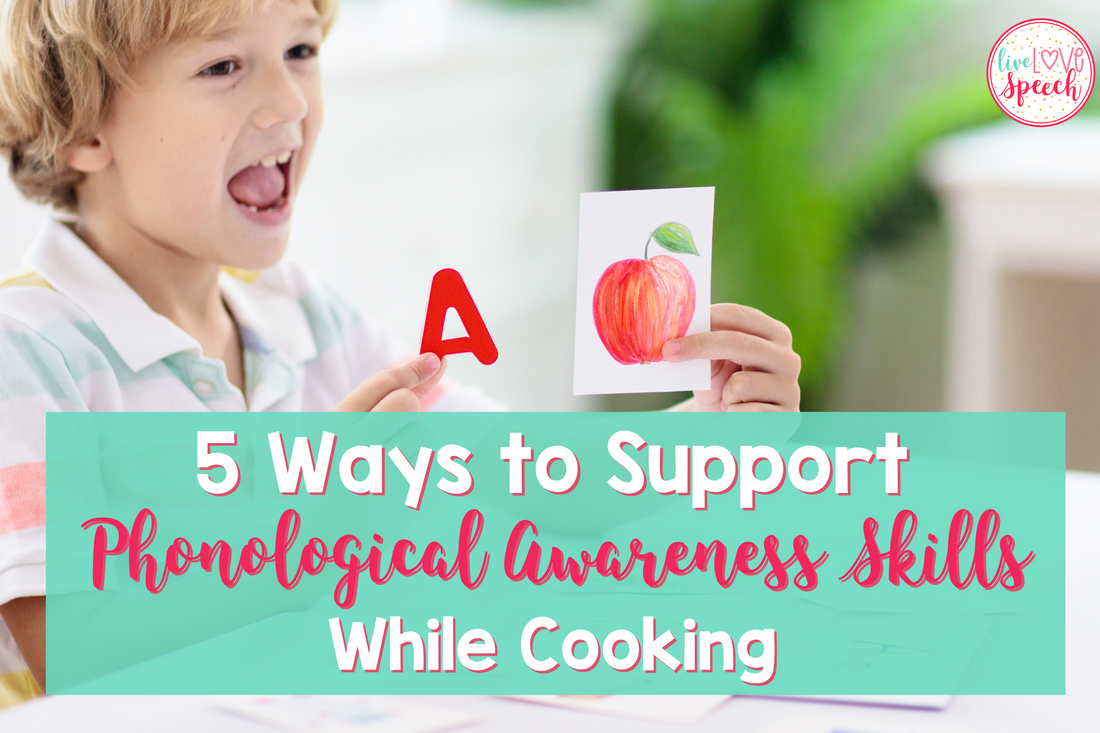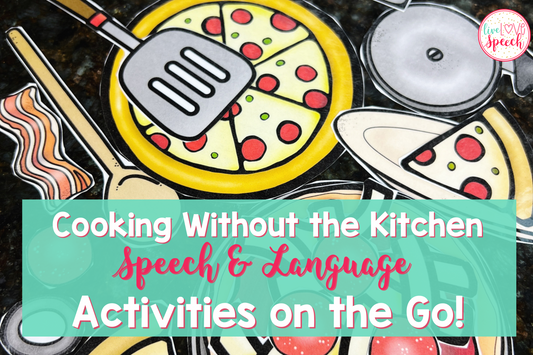
You know me, I LOVE to cook – it's something I've done my whole life. Whether it's experimenting with flavors or attempting intricate cooking crafts, the kitchen has always been my happy place. And when it came to being an SLP, I couldn't resist bringing my passion into the classroom & therapy room. Not only is cooking a super important life skill, it's also a great way to support many speech & language skills such as phonological awareness!
Sometimes working on phonological awareness has its challenges, and the traditional methods just need a little bit more creativity! So, in this blog post I wanted to spice things up and discuss how you can cook and target these skills at the same time!
What is Phonological Awareness?

As many of you may already know, phonological awareness is the foundation for learning to read. It’s the ability to recognize and change or work with sounds in spoken language. Phonemic awareness (tuning into the individual sounds in a word) is also a part of phonological awareness. Imagine it as the ability to hear the rhythm and patterns in words when people talk.
It's not just about kids listening; it's about them understanding the structure of words. Like, finding those tiny sound building blocks called phonemes. It's the ABCs of sound in language.
And it goes beyond that – have you ever had your students clap out the sounds in a word, like "el-e-phant"? That's breaking words into syllables!
WHY DOES IT MATTER?
Well, think of phonological awareness as the groundwork for mastering literacy skills. It's the key to helping kids understand how sounds come together to form words – a foundational skill crucial for successful reading and spelling.
Engaging in activities that boost phonological awareness is like giving our language skills a workout. Whether it's spotting rhyming words, clapping out syllables, blending individual sounds into words, or playing around with sounds within words, these activities act as the training ground for a solid foundation in reading and writing.
5 Ways to Support Phonological Awareness while Cooking!
1.Rhyming Ingredients:
Spicing up your cooking activities with Rhyming Ingredients! Instead of just focusing on the usual recipe steps, why not MIX IT UP and make it a playful language experience? Pick recipes with ingredients that rhyme – think "butter" and "mutter," "carrot" and "parrot," or "sauce" and "toss." It's a subtle way to turn your cooking activities into a wordplay haven.
As you're cooking, get your little chefs involved in the rhyming game. While you're chopping veggies or mixing, throw in a challenge. Ask them to find and repeat the words that rhyme, making sure they catch those similar sounds. It's like turning your cooking time into a laid-back language lesson – because, why not?
2.Sound Segmentation:

Practicing sound segmentation is breaking down the steps into individual sounds or syllables, adding a playful twist to your kids cooking experience. Let's look at making "pancakes"...
As you whip up the batter, involve your students in a language game. Ask them to identify and say each sound in the word "pancakes." It's like dissecting the word into bite-sized phonetic pieces – "pan-cakes." You can even add some rhythmic fun by clapping or tapping along with each syllable.
Create laughter and learning that can unfold as you flip those pancakes while clapping out the sounds. It's a multisensory experience that not only makes cooking more engaging but also sneakily enhances their language skills.
3. Phoneme Blending:
Let's incorporate phoneme blending by asking kids to listen for specific sounds in words as they cook. Take 'soup,' for example – it's not just a tasty meal; it's a chance to play with sounds.
While you're stirring your pot, invite your students to join in on some phonemic fun. Ask them to pick out the sounds in 'soup' – the starting sizzle, the middle slurp, and the final spoonful. Break it down: 's-o-u-p,' and blend those sounds together. There are so many different words to play with here and imagine your student's eyes lighting up as they realize that cooking is not just about flavors but about crafting words too!
4. Sound Substitution:

Sound Substitution is all about playing with words and turning your cooking activities into a language laboratory. So, as you're whipping up those 'muffins,' why not sprinkle in some phonics magic?
Challenge your kiddos to switch things up. Instead of just baking plain old 'muffins,' ask them to substitute the starting sound /m/ with /p/ – and voilà, you've got 'puffins'! Help them discover a whole new world of words. And here are a few more examples to spark their creativity: Cookies to Bookies, Pasta to Basta, Salad to Ballad, Banana to Cabana.
Encourage your students to experiment with different sounds and discover the endless word possibilities hiding in your cooking activities.
5. Phonemic Awareness Games:

Introduce phonemic awareness games during cooking. Take a break from the mixing and chopping to engage in a classic favorite: "I Spy."
Here's the game plan: say, "I spy with my little eye something that starts with the /s/ sound," and watch as your student's eyes light up with excitement. Now, the cooking activity becomes a treasure hunt for sounds! Encourage them to seek out ingredients or kitchen items that match the description.
As you continue preparing your food, keep the game rolling. Try different sounds and let their imagination run wild as they scan the classroom for items that fit the phonemic puzzle.
More Phonemic Awareness Activities!
My Grab N' Go Phonological Awareness resource is evidence-based and like the previous activities – a perfect addition to keep the phonemic party going strong.
These task cards are great for students diving into the world of words. You can use them for on-the-go therapy, centers, RTI sessions, or in-class therapy.
Here are some of the task cards included:
- Syllable Identification
- Phoneme Matching & Identification
- Rhyming
- Blending & Segmenting
- Phoneme Substitution
- Phoneme Addition & Deletion
Students/kids can bring their answers to life using magnetic chips, bingo daubers, play dough, or dry erase markers. It's like turning every session into a hands-on, interactive adventure.
Visual Recipe Cards
As if my phonological activities weren't exciting enough, I've got the perfect cherry on top – visual recipe cards that will make your cooking activities even more engaging!!
These visual recipe cards are kid-friendly, they make each step in your recipe crystal clear, and have step-by step instructions! No need to read off things to your child they can see for themselves! While you're mixing, stirring, and pouring, these visual recipe cards become a tool for learning. Rhyme while you mix, segment sounds while you chop – the possibilities are as endless as the recipe variations!
So, there you have it – the perfect pairing for our phonological activities. Visual recipe cards that not only simplify cooking but also amplify the learning part. It's a win-win in the kitchen! Grab your cards HERE!
SAVE THIS POST OR SHARE WITH YOUR BESTIE!
Pin this post for 5 ways to support phonological awareness skills while cooking!!








1 comment
This blog creatively links cooking and phonological awareness by suggesting playful, hands-on activities that strengthen listening, sound manipulation, vocabulary, and early literacy.